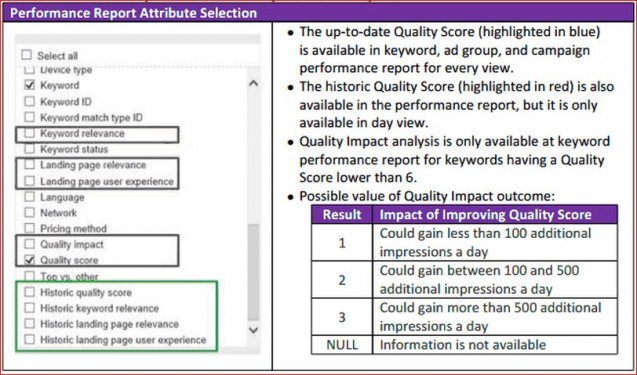As a Bing Ads product manager specializing in campaign optimization, I often get asked the differences between Quality Score on Bing Ads and AdWords. In order to answer that, we first have to understand why Quality Score was developed and its components. Simply, the goal of Bing Ads Quality Score is to help advertisers optimize the quality of their campaigns.
It’s designed to identify campaign optimization opportunities instead of measuring campaign optimization results. This approach enables Bing Ads to be more transparent in providing insights to advertisers through Quality Score so you can be more effective in improving your campaigns performance.
How Bing Ads calculates Quality Score
In order to provide broader and deeper insights, in addition to tracking the performance of individual keywords during the auction, Bing Ads also:
• Factors in marketplace competition while generating Quality Score by comparing potential click-through rate (aka: clickability) of your keywords to potential click-through rate of other keywords targeting the same traffic.
Example 1: Clickability Comparison

For search query: Seattle Golf vacation, there are four keywords compete for this traffic. Bing Ads compares clickability across those eligible keyword while generating Quality Score.
• Provides ad group and campaign level Quality Score by aggregating (impression weighted) associated keyword Quality Scores.
Example 2: Impression Weighted Aggregated Quality Score

Aggregated Quality Score is calculated by adding up each associated keyword’s Quality Score X its impressions and dividing it by the total impressions under this ad group or campaign.
• Generates Quality Scores for each individual match type because different match types exposes keywords, ads, and landing pages to different audiences and different competitors.
Bing Ads Quality Score Component
Exhibit 1: Quality Score components

See: http://advertising.microsoft.com/learning-center/best-practices/relevance-quality-quidelines
Exhibit 2: Screenshot of Bing Ads Quality Score

In addition to analyzing individual keyword’s potential CTR with competition, to help advertisers cultivate lifelong value of their customers, Bing Ads provides specific feedback on landing page relevance and landing page user experience from search users’ perspectives. In general, search users take two immediate actions after arriving in your landing pages:
- Locate information – searchers want to consume the information right away.
- Judge information – once located, searchers will assess whether the information addresses their intent.
For example, when people search for “Seattle golf vacation”, they want to access the information immediately and will assess whether the information enable them to proceed with their purchase journey of a golf vacation at Seattle. Over the years, I often notice some advertisers address only one of these two activities and lose out on opportunities to grow their business.
Using the same example, some landing pages ask searchers to enter a phone number or email address before showing general golf vacation information, which generates a poor user experience. Some landing pages show a long list of various vacation packages unrelated to golfing, also resulting in poor relevance.
How Bing Ads brings them together to generate the Quality Score
- Having a “Poor” in one of the subscores makes the ad less eligible to be served and could lower its Quality Score to below a 6.
- Not having a “Poor” in any of the subscores makes the keyword/ad fully eligible to be served and earns a Quality Score of 6 or higher.
- Having a “Good” Keyword Relevance subscore indicates the ad has a higher CTR than most of other keywords/ads targeting the same traffic and drives its Quality Score higher than 6.
Exhibit 3: Quality Score Decision Flow Chart

Exhibit 4: Quality Score Outcome

Best practices for adopting Quality Score
1. Bing Ads updates Quality Score daily. Use ad group and campaign level Quality Score to prioritize
- Keyword Relevance reflects whether ad copy effectively present selling point and call for actions, use it to track the performance of your ad copies.
- Landing Page Relevance reflects whether the content of the website could effectively address a searchers intent. Use it to identify opportunities of improving content relevancy or tightening search traffic with negative keywords or broad match modifiers.
- Landing Page User Experience reflects whether the website design allows searchers to consume content with ease. Use it to assess whether you are on track to convert each visitor into a customer.
2. Bing Ads provides historic Quality Scores at keyword, ad group, and campaign level. Use it to monitor campaign performance and marketplace dynamics.
3. Use Quality Impact analysis available in the Keyword Performance Report within Bing Ads to access the optimization efforts and use keyword level Quality Score to identify specific improvement opportunities. impressions lost due to a poor Quality Score to determine potential upside for improving campaign quality.
Exhibit 5: Select Quality Score attributes in performance reports

Other important FAQs on Quality Score
 Question: “I haven’t changed anything. Why has my Quality Score changed?”
Question: “I haven’t changed anything. Why has my Quality Score changed?”
Answer: While you haven’t changed anything, competitors keep optimizing their campaigns and become more competitive which may change your Quality Score. Use historic Quality Score to monitor the competition.
Question: “Will Bing Ads Quality Score directly affect ranking of my ads during auction?”
Answer: Bing Ads Quality Score is a strong indicator of your campaigns quality which is a key criterion in the marketplace auction.
Question: “Why do my high Quality Score Keywords have low actual CTR?”
Answer: Search engines don’t consider ad position while estimating clickability of ads and generating their Quality Score. A study conducted by compete.com found 85% of clicks happen in the top positions, so you should improve campaigns quality and bid competitively to earn a higher ad rank to collect more clicks.
Takeaways:
- Use historic Quality Score at the ad group and campaign level to monitor performance trends and cost to serve.
- Use up-to-date Quality Score at the keyword level to identify improvement opportunities.
- Searchers evaluate websites from both experience and relevance viewpoint, so present unique offers in a direct and concise fashion.
- Most clicks take place in the top positions, which demand competitive bids and superior campaign quality. Leverage Quality Score to improve your campaigns quality and to lower your campaigns cost.




